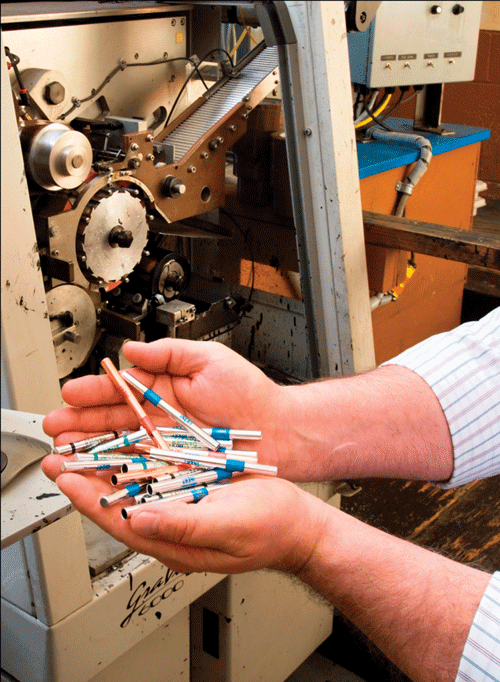For Gem Manufacturing of Waterbury, Conn., small parts mean big business.
The family-owned company produces precision deep-draw metal products, stampings and mechanical assemblies. It specializes in small components—most smaller than 4-inches long and 1/2-inch in diameter—made from steel, aluminum, brass and copper. Among the company’s broad portfolio are cigarette lighters and tire valves for automotive customers, as well as formed parts for electrical, explosives, industrial and medical applications.
Nearly all of Gem’s products are customer-specific designs, so meeting customer quality standards is critical to the success of the business.
Part of that means removing the synthetic and water-soluble drawing lubricants used in Gem’s transfer and progressive presses, as well as any other contaminants that could have a detrimental impact on performance.
“While our cleaning standards are not necessarily scientific, they are measurable and are especially vital for the detonators we produce for the mining and construction industries, and for military applications,” says Vice President Mark Caulfield, whose grandfather established the company in the 1950s. “You have to be able to print important data and information on the detonators, and they must be perfectly clean in order for the ink to adhere.”.
To meet that kind of exacting standard, as well as even simple cosmetic standards on other less-critical components, Gem relies on the SafeCare System as a key component of its metal cleaning and degreasing process.
Keeping It Clean with Solvents
The SafeCare system is a product of
SafeChem, a subsidiary of
Dow Chemical Company It enables operators to take advantage of the high-performance cleaning capability of chlorinated solvents, while limiting worker exposure and the potential of spills or emissions into the environment.
Before incorporating the SafeCare system, Gem was already committed to using solvents for its cleaning needs. The reason is simple, according to Caulfield.
“Solvents work,” he says. “They get the parts exceptionally clean. We looked at alternatives, but without solvents, we never achieved the cleanliness required. Take a look at detonators; they are essentially long, closed tubes, and they are difficult to clean. Aqueous offerings just don’t get it done.”
Adopting the SafeCare system was made even easier by the fact that Gem had installed a closed-top vapor degreaser in 1998.
“We used to contract with local vendors for our parts cleaning, but with the wide variety of oils they encountered, it was difficult for them to achieve the same level of cleaning we can in-house,” Caulfield says. “Sometimes we had to run them through twice, which increased costs. It just made sense to bring it in-house from cost and efficiency perspectives.”
However, in the years following Gem’s installation of the vapor degreasing equipment, environmental regulation standards grew more stringent, leading Gem to entertain other options in order to keep pace.
Hubbard-Hall Inc., a full-line industrial and specialty chemical distributor that supplies the SafeChem model in the region, presented an opportunity to try out the SafeCare system as a potential solution. Gem took advantage of the proposal from its long-time solvent and cleaning equipment supplier and hasn’t looked back.
“The system is very easy for us to use,” says John Daikus, Gem maintenance foreman. “The self-contained units are easy to maneuver, cutting down on potential ergonomic injuries, and our people never come in contact with solvent. Plus the elimination of secondary containment equipment frees up valuable shop-floor space.”
Minimizing Risk in the Cleaning Process
With the SafeCare system, virgin chlorinated solvent supplied by Dow is delivered in double-walled and sealed containers. In Gem’s case, the solvent is Dowper SVG double-stabilized perchloroethylene solvent, which the company says is highly effective for heavy-duty cleaning and degreasing where there are high levels of contamination. It is specially stabilized to prevent acid buildup in vapor degreasers like the one Gem uses.
New solvent is transferred to cleaning equipment using leak-resistant couplings, adapters and other measures designed to dramatically reduce the risk of spills or emissions. Used solvent is transferred to equally secure recycling containers using similar safeguards. Solvent delivery and pickup is handled by qualified chemical distribution and waste management firms like Hubbard-Hall, simplifying the process for the user.
“Gem was an ideal candidate for the SafeCare system based on its metallurgical and cleaning expertise and experience,” says Chris Carrozzo, Hubbard-Hall sales manager. “Its desire to not only meet customer cleaning standards, but to effectively manage worker health and safety and environmental impact dovetail nicely with the capabilities of the SafeCare system.”
In addition to the system itself, Hubbard-Hall and SafeChem provide customers with technical support and services that help maintain solvent quality and optimize the cleaning process. These services include solvent training, comprehensive analytical laboratory services, test kits for on-site self-testing, solvent stabilizers and additives.
“We’ve been very satisfied with the implementation of the SafeCare system; it’s been a remarkably smooth transition,” Caulfield says. “Ultimately, we anticipate the system will reduce our solvent use and reduce our costs. But even if it didn’t do that, its ease of use and other features allow us to handle solvents safely and manage the cost of regulatory compliance, making it a valuable addition to our process. And since we’ve essentially eliminated solvent odors in our facility, it’s just a more pleasant working environment, which makes everyone happy.”
For more information on Dow’s SafeChem, please visit Dowsafechem.com or call 877-376-8343. For information on Hubbard-Hall, please visit Hubbardhall.com or call 800-648-3412.





















